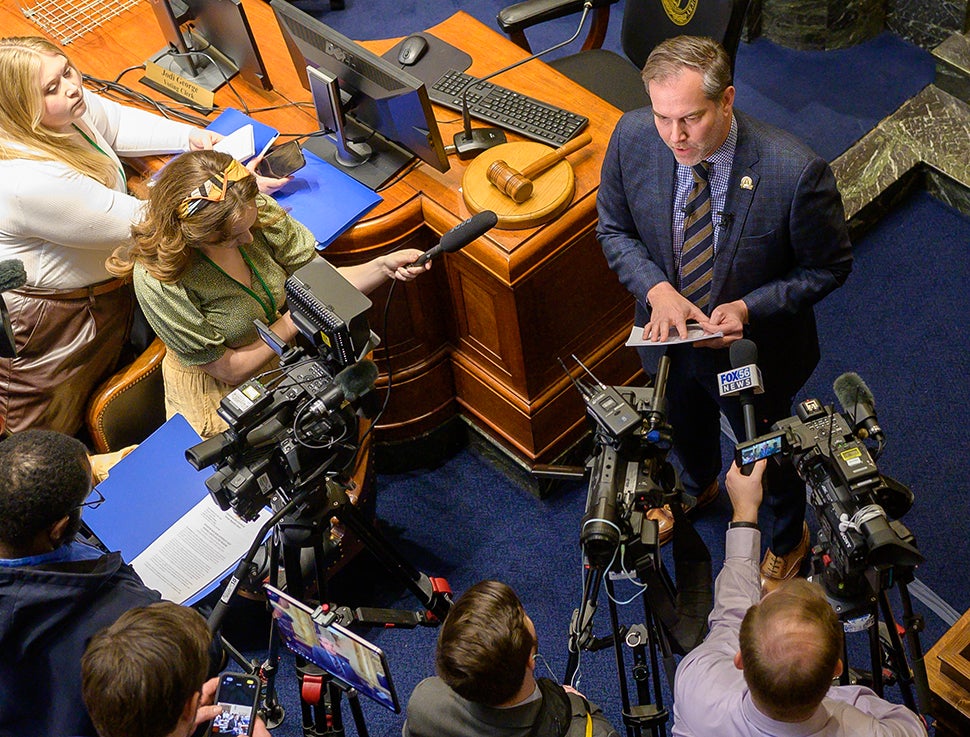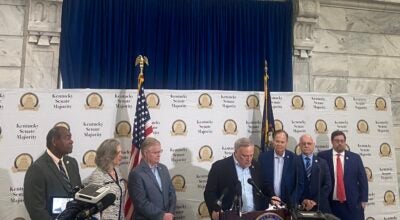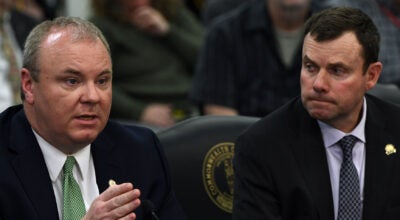School safety guardian bill becomes law without governor
Published 10:22 am Friday, April 12, 2024

- FRANKFORT, Feb. 22 – Sen. Max Wise, R-Campbellsville, is surrounded by media Thursday as he fields questions on Senate Bill 2, legislation focused on school safety. (LRC Public Information)
FRANKFORT — A bill potentially bringing guardians into schools as a stopgap safety measure will become law.
Gov. Andy Beshear allowed Senate Bill 2, an update to the 2019 School Safety and Resiliency Act, to become law without his signature.
Beshear said when he chooses to let a bill lapse into law in this way, it’s because he believes it’s not a “black or white” issue; it contains good and bad parts.
Also, he knew the legislature would override his veto and wants to be in the best position he can to provide input for the guardian program moving forward.
“Do I have worries about who might be in our schools with this? Yes,” he said. “Are there some real significant limitations within the bill on the training and the tests and everything else people have to pass? Yes. Is it entirely voluntary for school districts to do this or not? That answer is yes, too.”
Sen. Max Wise, R-Campbellsville, said he’s “pleased” SB2 will become law in a press release.
“This General Assembly is taking critical steps today that will enhance the safety of our children and teachers through our Kentucky Guardian Program and will provide extra mental health support through enhanced collaboration among mental health professionals,” Wise said.
What does SB2 do?
In 2019, the first iteration of the School Safety and Resiliency Act became law.
Filed in response to the 2018 Marshall County school shooting, it required schools to employ school resource officers with arresting authority as an additional safety measure.
However, SROs were an unfunded mandate, and five years later, there are approximately 600 campuses still without an officer.
Wise filed SB2 this session to provide an alternative while districts continue working to hire SROs. It allows districts to bring in guardians—honorably discharged veterans, retired Kentucky state troopers, retired special and sworn law enforcement officers, and former federal law enforcement officers—in the meantime.
Guardians do not have arresting authority, but can carry weapons. Local districts may decide whether guardians are volunteer or paid positions, or whether to use this option at all.
Guardians must undergo 160 training hours, including the first of three levels of SRO training as well as courses on active shooter response, enhanced handgun performance and patrol rifles.
Before entering schools, they also must submit to a background check, psychological screening and polygraph exam.
Bill opponents say the state should address violence with fewer guns, not more. Supporters say it’s better to have someone ready to respond to an emergency than no one.
SB2 also updates some of the School Safety and Resiliency Act’s mental health provisions.
The current law aims to meet a ratio of one school counselor for every 250 students. In the 2022-23 academic year, 51% of Kentucky’s public schools met this goal, according to the state school security marshal’s annual report.
It also required schools to create trauma-informed teams. This year’s SB2 clarifies these teams’ responsibilities.
Trauma-informed teams are made up of school counselors, social workers, psychologists, SROs and other mental health services providers.
These teams are charged to help schools identify and support students whose learning, behavior or relationships are impacted by trauma, as well as building resiliency and wellness across the student body.
SB2 also doubles suicide prevention awareness lessons, from one to two, and lowers the grade level from grades 6-12 to grade four.
Finally, the Department of Education must gather data on the state of mental health in Kentucky schools. They will compile information about the numbers and types of mental health services providers, trauma-informed approach plans and Medicaid billing for mental health services.
The recently passed biennial budget includes some funding to supplement this bill’s effort.
It appropriates $34.5 million for SROs, up to $20,000 per campus, $7.4 for school-based mental health service providers and $30 million to the Center for School Safety.





